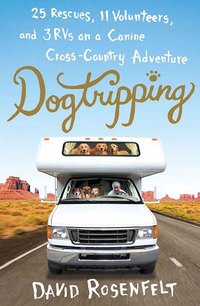 Dogtripping:
Dogtripping:
25 Rescues, 11 Volunteers,
and 3 RVs on Our Canine
Cross-Country Adventure
DETAILS: Publisher: St. Martin's Press Publication Date: July 23, 2013 Format: Hardcover Length: 278 pg. Read Date: January 19-20, 2022

The overriding view of everyone was that it was going to be a great adventure, successful and a hell of a lot of fun.
Except for me.
I was expecting a disaster.
What’s Dogtripping About?
After a decade and a half or so of running their dog rescue in southern California, David Rosenfelt and his wife decide to move out of California (a very close call with a wildfire is a primary impetus for this) to Maine. But they have a bigger logistical challenge than most of us do when we make a move—either cross-town or cross-country. Sure, it can be hard to figure out the best way to move a piano or a fragile heirloom—but ultimately, that’s something that people do all the time. But how do you get twenty-five dogs cross-country?
First of all, you need help—and we’re not talking the kind of help where you get a few friends together, promise a pizza and a six-pack to split, and get them to help you move a piano or a sofa. This is a bigger project. You also have to figure out what kind of vehicle—or vehicles—will be needed, where you all will sleep, how can you deal with the bathroom breaks, and so on.
Right there, that’s an interesting story, many people—especially dog lovers would read that. When the talented and amusing author of the Andy Carpenter novels tells the story, it becomes an entertaining read.
Interspersed between chapters discussing the preparation for the trip and the trip itself are chapters describing the background for The Tara Foundation (starting with the dog it’s named after), the development and growth of their rescue efforts, and profiles of some of the dogs.
Dog Profiles
My favorite parts of the book are the 2-3 page profiles of some of the dogs that have stayed with their pack—for anywhere from a week to several years. He starts by describing how the dog came to their attention, then he talks about the specific challenges for that dog, their personality, and how they integrated into the menagerie. Then he’ll describe how they took to the move—if they were part of that 25—found a family to adopt them, or how their life came to an end.
Obviously, I preferred reading the first two endings—but they’ve been at this for a long time, and most of their rescues are senior dogs, it’s a reality they have to deal with far too often. Not always, but I generally got a little misty for those other endings. Rosenfelt has a real knack for making you grin/chuckle, telling a heartwarming story, and then hitting you with the sadness that comes from the brevity of canine life.
Still, I’d read an entry on every dog they ever had in their shelter and come back for more.
Incidentally, he includes some really sound advice on deciding when to put an ailing dog to sleep.*
* Please, no one tell my almost 16-year old Pug/Beagle mix that I read anything about that. No need to stress her out.
Too Many Italics
I am not a fan of extended sections of italics—there are better ways to set aside chunks of text (going to a sans serif typeface, for example), but I’m mostly used to them. A character’s thoughts—usually a sentence or two–I can handle. I can even put up with a few paragraphs for a dream sequence or flashback or something. But whole chapters really bug me.
And that’s what we get here—and not just a few, but several. There’s no set pattern, but typically a couple of chapters in regular type (one of them being really brief) and then one in italics. It’s very aggravating.
But here’s the worst part—it’s the chapters that are about the subject of the book that are italicized! The background chapters, the chapters that profile individual dogs, or are just full of Rosenfelt talking about some topic (for example: their efforts to keep the smell of all their dogs using the back yard as a bathroom from bothering the neighbors) are all in regular type. But the part of the book that the title and subtitle describe are italicized.
I don’t understand that choice. I certainly didn’t enjoy it.
So, what did I think about Dogtripping?
Twenty-five is pretty much the fewest dogs Debbie and I have had in the last ten years. We’ve had as many as forty-two, but we feel that more than forty is slightly eccentric.
This was a fast, fun read—with some really touching moments mixed in.
I’m going to borrow the conclusion to my post about Rosenfelt’s other book about their rescues, Lessons from Tara, because it works just as well here, and I’m tired:
Fans of the Andy Carpenter series will be happy to hear that Andy’s voice is Rosenfelt’s—the book at times feels like an Andy Carpenter book without all the muss and fuss of a plot, murder, or trial. I laughed, I chuckled, I learned a thing or two, and I even got misty more than I wanted to. All in all a really strong read. If you’re a dog lover, or just someone who likes to read good things, find some time for this one.

This post contains an affiliate link. If you purchase from it, I will get a small commission at no additional cost to you. As always, opinions are my own.
![]()




wittysarcasticbookclub
You find the most unique books!
HCNewton
Eh, not sure it was much of a find. I’ve read 24 novels of his, if he writes something about dogs (my kryptonite) you know it’s going to end up on my TBR. 🙂
HCNewton
(that said, I sure try)